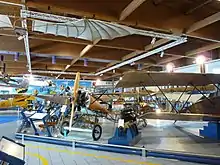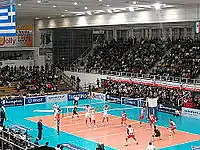Trento
Trento (Italian: [ˈtrento] ⓘ or [ˈtrɛnto];[3] Ladin and Lombard: Trent; German: Trient [tʁiˈɛnt] ⓘ; Cimbrian: Tria;[4] Mócheno: Trea't; Latin: Tridentum), also known in English as Trent,[5] is a city on the Adige River in Trentino-Alto Adige/Südtirol in Italy. It is the capital of the autonomous province of Trento. In the 16th century, the city was the location of the Council of Trent. Formerly part of Austria and Austria-Hungary, it was annexed by Italy in 1919. With 118,142 inhabitants,[6] Trento is the third largest city in the Alps and second largest in the historical region of Tyrol.
Trento
| |
|---|---|
| Comune di Trento | |
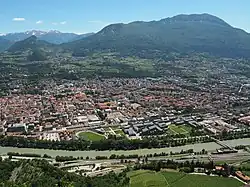 Panorama of Trento | |
 Flag  Coat of arms | |
Location of Trento | |
 Trento Location of Trento in Trentino-Alto Adige/Südtirol 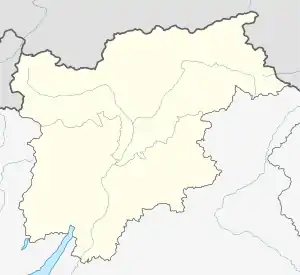 Trento Trento (Trentino-Alto Adige/Südtirol) | |
| Coordinates: 46°04′N 11°07′E | |
| Country | Italy |
| Region | Trentino-Alto Adige/Südtirol |
| Province | Trentino (TN) |
| Frazioni | see list |
| Government | |
| • Mayor | Franco Ianeselli |
| Area | |
| • Total | 157.9 km2 (61.0 sq mi) |
| Elevation | 194 m (636 ft) |
| Population (2020)[2] | |
| • Total | 120,709 |
| • Density | 760/km2 (2,000/sq mi) |
| Demonym(s) | Trentini, Tridentini |
| Time zone | UTC+1 (CET) |
| • Summer (DST) | UTC+2 (CEST) |
| Postal code | 38121-38122-38123 |
| Dialing code | 0461 |
| Patron saint | Saint Vigilius |
| Saint day | June 26 |
| Website | Official website |
Trento is an educational, scientific, financial and political centre in Trentino-Alto Adige/Südtirol, in Tyrol and Northern Italy in general. The city contains a picturesque Medieval and Renaissance historic centre, with ancient buildings such as Trento Cathedral and the Castello del Buonconsiglio.
Together with other Alpine towns Trento engages in the Alpine Town of the Year Association for the implementation of the Alpine Convention to achieve sustainable development in the Alpine Arc. Trento was awarded the title of Alpine Town of the Year 2004.
The city often ranks highly among Italian cities for quality of life, standard of living, and business and job opportunities, being ranked 5th in 2017.[7] Trento is also one of the nation's wealthiest and most prosperous cities, with its province being one of the richest in Italy, with a GDP per capita of €31,200 and a nominal GDP of €16.563 billion.[8]
The University of Trento, founded in 1962 as a Higher University Institute of Social Sciences, is one of the most prestigious medium-small Italian universities, with a strong international vocation. It ranks 1st among 'medium-sized' Universities in the Censis ranking[9] and 2nd in the Il Sole 24 Ore ranking of Italian universities.[10]
The School of International Studies of the University of Trento is a member of the Association of Professional Schools of International Affairs (Apsia),[11] a selected group of institutions for higher education in the field of international relations. It is the first, and currently unique, Italian institute and one of the few Europeans present in the club of the best international study schools in the world that form policy makers.
In the last twenty years, thanks to the gradual creation of various research centers (FBK, FEM) and laboratories in the IT, engineering and sciences fields, Trento and its university have been nicknamed the "Silicon Valley of the Alps".[12]
History
The origins of this city on the river-route to Bolzano and the low Alpine passes of Brenner and the Reschen Pass[13] over the Alps are disputed. Some scholars maintain it was a Rhaetian settlement: the Adige area was however influenced by neighbouring populations, including the (Adriatic) Veneti, the Etruscans and the Gauls (a Celtic population). According to other theories, the latter instead founded the city during the 4th century BC.
Trento was conquered by the Romans in the 1st century BC, after several clashes with the Rhaetian tribes. Before the Romans, Trento was a Celtic village. Julius Caesar re-founded it as a Roman municipality when Rome extended citizenship to the part of Cisalpine Gaul north of the River Po.[14][15] The Latin name given to the settlement was Tridentum, meaning "Three-teeth place" or "Trident-town" (tri- "three" + dēns, dent- "tooth"). The reason for the name is uncertain: the new town may have been consecrated to the god Neptune, or possibly named after the three hills that surround the city (known in Italian as Doss Trento, Doss di Sant'Agata and Doss di San Rocco). The Latin name is the source of the adjective "tridentine". On the old city hall, a Latin inscription is still visible: "Montes argentum mihi dant nomenque Tridentum" ("Mountains give me silver and the name of Trento"), attributed to Fra' Bartolomeo da Trento (died in 1251). Tridentum became an important stop on the Roman road that led from Verona to Innsbruck.[16]


After the fall of the Western Roman Empire, the independent bishopric of Trento was conquered by Ostrogoths, Byzantines, Lombards and Franks, finally becoming part of the Holy Roman Empire. In 1027, Emperor Conrad II created the Prince-Bishops of Trento, who wielded both temporal and religious powers. In the following centuries, however, the sovereignty was divided between the Bishopric of Trent and the County of Tyrol (from 1363 part of the Habsburg monarchy). Around 1200, Trento became a mining center of some significance: silver was mined from the Monte Calisio – Khalisperg, and Prince-Bishop Federico Wanga issued the first mining code of the alpine region.
In the 14th century, the region of Trento was part of Austria.[17] The dukes of Austria (Habsburg Family) were also the counts of Tyrol and dominated the region for six centuries (1918).
A dark episode in the history of Trento was the Trento blood libel. When a 3-year-old Christian boy, Simonino, later known as Simon of Trent, disappeared in 1475 on the eve of Good Friday, the city's small Jewish community was accused of killing him and draining his blood for Jewish ritual purposes.[18] Eight Jews were tortured and burned at the stake, and their families forced to convert to Christianity. The bishop of Trento, Johannes Hinderbach, had Simonino canonized and published the first book printed in Trento, "Story of a Christian Child Murdered at Trento", embellished with 12 woodcuts.[18] In a governmental ceremony in the 1990s, Trento apologized to the Jewish community for this dark episode and unveiled a plaque commemorating the formal apology.
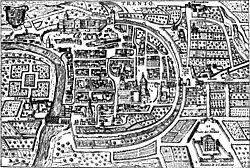
In the 16th century, Trento became notable for the Council of Trent (1545–1563) which gave rise to the Counter-Reformation. The adjective Tridentine (as in "Tridentine Mass") literally means pertaining to Trento, but can also refer to that specific event. Among the notable prince-bishops of this time were Bernardo Clesio (who governed the city from 1514 to 1539 and managed to steer the council to Trento) and Cristoforo Madruzzo (who governed from 1539 to 1567), both able European politicians and Renaissance humanists, who greatly expanded and embellished the city.
During this period, and as an expression of this Humanism, Trento was also known as the site of a Jewish printing press. In 1558 Cardinal Madruzzo granted the privilege of printing Hebrew books to Joseph Ottolengo, a German rabbi. The actual printer was Jacob Marcaria, a local physician; after his death in 1562, the activity of the press of Riva di Trento ceased. Altogether, 34 works were published in the period from 1558 to 1562, most of them bearing the coat of arms of Madruzzo.[20]
Prince-bishops governed Trento until the Napoleonic era, when it changed hands among various states. Under the reorganization of the Holy Roman Empire in 1802, the Bishopric was secularized and annexed to the Habsburg territories. The Treaty of Pressburg in 1805 ceded Trento to Bavaria, and the Treaty of Schönbrunn four years later gave it to Napoleon's Kingdom of Italy.
The population staged armed resistance to French domination. The resistance leader was Andreas Hofer. During his youth, he lived in Italian Tyrol, where he learned the Italian language. When Hofer recovered Trento for the Austrians (1809), he was welcomed with enthusiasm by the population of Trento. Approximately 4,000 Trentinian volunteers (Sìzzeri or Schützen) died in battle against the French and Bavarian troops. In 1810, Hofer was captured and brought to Mantua, and was shot by French soldiers on the express order of Napoleon.
With Napoleon's defeat in 1814, Trento was again annexed by the Habsburg Empire. Church government was finally extinguished, and Trento was henceforth governed by the secular administration of Tyrol. In the following decades, Trento experienced a modernization of administration and economy with the first railroad in the Adige valley opening in 1859. The entire Mediterranean basin was at risk of malaria, a factor that affected the entire Italian peninsula and this Alpine region was not spared. Even Tuscany was particularly hard hit; malaria existed far inland into the Veneto area, reaching the Italian Alps.[21] From 1918 to 1940, government figures show Italy's malaria deaths decreased by 96%, due to the efforts of the Rockefeller Foundation and Italy's own malaria experts, who themselves were international leaders in malariology.[22]
During the late 19th century, Trento and Trieste, cities with ethnic Italian majorities still belonging to the Austrians, became icons of the Italian irredentist movement. Benito Mussolini briefly joined the staff of a local newspaper in 1909, but left Trento because they could not create an anti-Austrian group. There was dissatisfaction with the lack of provincial autonomy and the failure to establish a university for the region. Feelings of loyalty were focused on the 'father-figure' emperor, not for Austria.
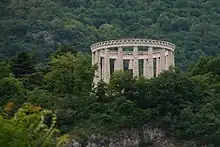
The nationalist cause led Italy into World War I. Damiano Chiesa and the deputy in the Austrian parliament Cesare Battisti were two well-known local irredentists who had joined the Italian Army to fight against Austria-Hungary with the aim of bringing the territory of Trento into the new Kingdom of Italy. The two men were taken prisoners at the nearby southern front. They were put on trial for high treason and executed in the courtyard of Castello del Buonconsiglio.
The region was greatly affected during the war, and some of its fiercest battles were fought on the surrounding mountains in the southernmost regions and the southeast. Of a population of just less than 400,000 in the province, 55,000 men served in the Imperial and Royal Army of whom 11,000 died. Most served on the Galician front; 700 served with the Italian Army. After World War I, Trento and its Italian-speaking province, along with Bolzano (Bozen) and the part of Tyrol that stretched south of the Alpine watershed (which was primarily German-speaking, as still is to this day), were annexed by Italy.
In July 1943 Mussolini was removed as Prime Minister when the allies invaded Sicily. Italy surrendered to the Allies, and declared war on Germany. German troops promptly invaded northern Italy and the provinces of Trento, Belluno and South Tyrol became part of the Operation Zone of the Alpine Foothills, annexed to Germany. Some German-speakers wanted revenge upon Italian-speakers living in the area, but were mostly prevented by the occupying German troops, who still considered Mussolini head of the Italian Social Republic and wanted to preserve good relations with the Italians. From November 1944 to April 1945, Trento was bombed as part of the so-called "Battle of the Brenner". War supplies from Germany to support the Gothic Line were for the most part routed via the rail line through the Brenner Pass. Over 6,849 sorties were flown by the Allies over targets from Verona to the Brenner Pass, with 10,267 tons of bombs dropped. Parts of the city were hit by the Allied bombings, including the church of S. Maria Maggiore, the Church of the Annunciation and several bridges over the Adige river. In spite of the bombings, most of the medieval and renaissance city center was spared. It was finally liberated on 3 May 1945.
In 1947, Trento became the host of the Rally Stella Alpina.
Since the 1950s, the region has enjoyed prosperous growth, thanks in part to its special autonomy from the central Italian government.
On 4 August 2015, the cathedral tower caught fire by "spontaneous combustion". The clock stopped at 10:50 AM, a matter of minutes after the fire began.
In 2020, Trento was listed as the most sustainable city in Italy, according to the Smart City Index.[23]
Geography
The township of Trento encompasses the city centre as well as many suburbs of extremely varied geographical and population conditions (from the industrial suburb of Gardolo, just north of the city, to tiny mountain hamlets on Monte Bondone). Various distinctive suburbs still retain their traditional identity of rural or mountain villages.
Trento lies in a wide glacial valley known as the Adige valley, just south of the Dolomite Mountains, where the Fersina River and Avisio rivers join the Adige River (the second longest river in Italy). River Adige is one of the three primary south-flowing Alpine rivers; its broadly curving course alongside Trento was straightened in 1850.[24] The valley is surrounded by mountains, including Vigolana (2,150 m (7,050 ft)), Monte Bondone (2,181 m (7,156 ft)), Paganella (2,124 m (6,969 ft)), Marzola (1,747 m (5,732 ft)) and Monte Calisio (1,096 m (3,596 ft)). Nearby lakes include Lake Caldonazzo, Lake Levico, Lake Garda and Lake Toblino.
Frazioni
Frazioni, or subdivisions of Trento:
- Povo
- Villazzano
- Gardolo
- Roncafort
- Mattarello
- Martignano
- Cognola
- Ravina
- Romagnano
- Montevaccino
- Vela
- Meano
- Sardagna
- Sopramonte
- Vigo Meano
- Cortesano
- Gazzadina
- Candriai
- Vaneze
- Cadine
- Vigolo Baselga
Climate
The municipality of Trento stretches across a wide range of altitude levels, going from just under 200 m above sea level at the city centre, to 400 m in Povo and Cognola, to 2000 m above sea level at Monte Bondone, boroughs at higher elevation, for instance Viote, have a colder alpine climate (Dw). Urban Trento has a humid subtropical-continental climate (Cfa-Dfa) according to the Köppen climate classification. Monthly average temperatures range between 1.6 °C (January) and 23.4 °C (July). Average annual precipitation exceeds 900 mm spread out on an average of 87 days, with peaks in late spring (May–June, 90 mm monthly average in 9–10 rain days) and autumn (October–November: 100–110 mm monthly average in 7–8 days), and lows in winter (January–February, 30–40 mm monthly average in 3–4 rain days). Winters are cold to freezing, with infrequent snowfall but usual frost from mid-November to mid-March. In winter, daytime highs may not exceed 5 °C and lows may rarely dip down to -10 °C, but the former usually stand around 8°C, while the latter usually hover between -3 °C to 0 °C. Spring brings unpredictable weather with wind blowing north to south or vice-versa through the valley. Many spring days are pleasant, but the transition may be very quick, for example going from frosty mornings to 30 °C in two months. In May, it is possible to have either rainy days with daytime highs below 18 °C, or sunny days with the temperature soaring up to 30 °C. Summers are hot, sometimes sweltering, with highs getting to 35 °C at least for a week a year and more rarely to 38 °C. Summer nights can be hot as well, with overnight lows hovering around 22-24 °C (in the hilly suburbs east, north and west of Trento summer nights can be much cooler, with overnight temperature differing by up to 6 °C from the ones experienced in the city centre). Early fall is pleasant, with foliage starting around mid-October at higher elevations, late October in the uphill suburbs and in November downtown. Fall days can be humid, grey and dim, with temperatures rapidly declining through October and November. The first snowfall in the suburbs may occur as early as late November, with December and early January being the snowiest period of the year.
| Climate data for Trento Laste, elevation: 312 m (1981–2010, extremes 1958–2010) | |||||||||||||
|---|---|---|---|---|---|---|---|---|---|---|---|---|---|
| Month | Jan | Feb | Mar | Apr | May | Jun | Jul | Aug | Sep | Oct | Nov | Dec | Year |
| Record high °C (°F) | 19.2 (66.6) |
23.6 (74.5) |
29.0 (84.2) |
31.0 (87.8) |
37.4 (99.3) |
38.9 (102.0) |
39.5 (103.1) |
41.4 (106.5) |
33.5 (92.3) |
28.3 (82.9) |
22.8 (73.0) |
16.6 (61.9) |
41.4 (106.5) |
| Average high °C (°F) | 5.2 (41.4) |
9.2 (48.6) |
15.2 (59.4) |
18.5 (65.3) |
23.1 (73.6) |
26.8 (80.2) |
29.4 (84.9) |
28.3 (82.9) |
22.8 (73.0) |
16.4 (61.5) |
9.5 (49.1) |
4.9 (40.8) |
17.4 (63.3) |
| Daily mean °C (°F) | 1.6 (34.9) |
4.3 (39.7) |
9.5 (49.1) |
13.0 (55.4) |
17.6 (63.7) |
21.1 (70.0) |
23.4 (74.1) |
22.5 (72.5) |
17.8 (64.0) |
12.4 (54.3) |
5.9 (42.6) |
1.7 (35.1) |
12.6 (54.7) |
| Average low °C (°F) | −2.1 (28.2) |
−0.6 (30.9) |
3.9 (39.0) |
7.6 (45.7) |
12.2 (54.0) |
15.4 (59.7) |
17.4 (63.3) |
16.7 (62.1) |
12.8 (55.0) |
8.3 (46.9) |
2.4 (36.3) |
−1.5 (29.3) |
7.7 (45.9) |
| Record low °C (°F) | −15.2 (4.6) |
−11.3 (11.7) |
−10.1 (13.8) |
−2.7 (27.1) |
1.5 (34.7) |
6.3 (43.3) |
9.5 (49.1) |
7.2 (45.0) |
3.3 (37.9) |
−3.7 (25.3) |
−6.6 (20.1) |
−12.3 (9.9) |
−15.2 (4.6) |
| Average precipitation mm (inches) | 42.1 (1.66) |
33.9 (1.33) |
54.0 (2.13) |
78.1 (3.07) |
94.4 (3.72) |
92.4 (3.64) |
86.7 (3.41) |
83.8 (3.30) |
82.3 (3.24) |
116.8 (4.60) |
106.2 (4.18) |
65.8 (2.59) |
936.6 (36.87) |
| Average snowfall cm (inches) | 19.2 (7.6) |
9.8 (3.9) |
3.1 (1.2) |
0.3 (0.1) |
0.0 (0.0) |
0.0 (0.0) |
0.0 (0.0) |
0.0 (0.0) |
0.0 (0.0) |
0.1 (0.0) |
2.8 (1.1) |
14.3 (5.6) |
49.6 (19.5) |
| Average precipitation days | 4.0 | 3.4 | 5.7 | 8.2 | 9.5 | 9.5 | 8.2 | 8.1 | 7.0 | 7.6 | 7.1 | 5.5 | 83.7 |
| Average relative humidity (%) | 69 | 66 | 66 | 69 | 72 | 71 | 71 | 72 | 73 | 77 | 75 | 59 | 70 |
| Source 1: Agenzia Provinciale per la Protezione dell'Ambiente[25] | |||||||||||||
| Source 2: Meteotrentino[26] | |||||||||||||
Demographics
In 2007, there were 112,637 people residing in Trento, of whom 48% were male and 52% were female. Minors (children ages 18 and younger) totalled 18.01 percent of the population compared to pensioners who numbered 19.37 percent. This compares with the Italian average of 18.06 percent (minors) and 19.94 percent (pensioners). The average age of Trento residents is 41 compared to the Italian average of 42. In the five years between 2002 and 2007, the population of Trento grew by 5.72 percent, while Italy as a whole grew by 3.56 percent.[27] The current birth rate of Trento is 9.61 births per 1,000 inhabitants compared to the Italian average of 9.45 births.
As of 2006, 92.68% of the population was Italian. The largest immigrant group came from other European countries (mostly Albania, Romania): 4.13%, North Africa: 1.08%, and the Americas: 0.85%.
Trento Informa (a magazine distributed by the "comune") reports that in 2011 there were 117,190 people residing in Trento, of whom 48.5% aged between 45 and 65. The average age was 43.1 years.
Economy
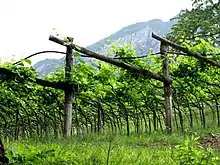
The city owes much of its unique economy to its position along the main communication route between Italy and Northern Europe and to the Adige river which, prior to its diversion in the mid-19th century, ran through the center of the city. The Adige river was formerly a navigable river and one of the main commercial routes in the Alps. The original course of the river is now covered by the Via Torre Vanga, Via Torre Verde and the Via Alessandro Manzoni.
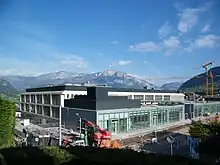
As late as World War II, Trento depended on wine-making and silk.[28] Sparkling wine made in the Trentino province is part of the Trento DOC classification. The manufacturing industry installed in the post-war period has been mostly dismantled. Today, Trento thrives on commerce, services, tourism, high-quality agriculture and food industry (including wine and fruit), as a research and conference center thanks to a small but renowned university and internationally renowned research centers such as Fondazione Bruno Kessler, active in both fundamental and applied research, the Italian-German Historical Institute, the Centre for Computational and Systems Biology and ECT*, active in theoretical nuclear studies and part of FBK, and as logistics and transportation thoroughfare.
Valued pink and white porphyry are still excavated from some surrounding areas (Pila). This stone can be seen in many of Trento's buildings, both new and old.
The city has two long-running annual sporting events: the Giro al Sas (a 10 km (6 mi) professional road running competition) was first held in the city in 1907 and continues to the present,[29] while the Giro del Trentino is an annual road cycling race which the city has hosted every year since 1963.[30]
Economy Festival of Trento
The Festival dell’Economia di Trento (Economy Festival of Trento) was brought into being in 2006 in order to enable and facilitate discussions between economists and a broad public. The aim of this festival is to put economic terminology across to everyone. The festival takes place every year at the end of May on the historic Palazzi of the old town in Trento. Well known economists explain and interpret current economic issues, both from an economic-scientific as well as from a social and entrepreneurial viewpoint. In the course of recent years, numerous economic scholars and managers such as Sir Anthony Atkinson, Fan Gang, Zygmunt Bauman and the Nobel Prize winner Gary Becker took an active part.[31]
Politics
Government
Trento is governed by the City Council of Trento. Voters elect directly 40 councilors and the mayor of Trento every five years. The current mayor of Trento is Franco Ianeselli, elected for the first time on 21 September 2020. Ianeselli, a former trade unionist, was elected as a left-leaning independent with the support of a wide coalition of parties. These parties ranged from the left (as in the case of Europa Verde) to the Catholic centre (including Partito Autonomista Trentino Tirolese, and Insieme per Trento). When determining the composition of his Giunta (the equivalent of a City Cabinet), Ianeselli selected seven members of the City Council: Monica Baggia, Elisabetta Bozzarelli, Mariachiara Franzoia, Chiara Maule, Salvatore Panetta, Roberto Stanchina, and Paolo Zanella. However, in late November 2020 Paolo Zanella announced he would leave his position as a member of the Giunta, in order to fill a vacancy in one of the 35 seats of the legislative assembly of the Trentino province, upon the resignation of member Paolo Ghezzi. Shortly after, mayor Ianeselli announced Ezio Facchin as Zanella's successor.
Euroregion Tyrol-South Tyrol-Trentino
In 1996, the European Union approved further cultural and economic integration between the Austrian province of Tyrol and the Italian autonomous provinces of South Tyrol and Trentino by recognizing the creation of the Euroregion Tyrol-South Tyrol-Trentino.
Main sights
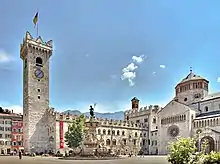
Although off the beaten path of mass tourism, Trento offers rather interesting monuments. Its architecture has a unique feel, with both Italian Renaissance and Roman influences. The city center is small, and most Late-Medieval and Renaissance buildings have been restored to their original pastel colours and wooden balconies. Part of the medieval city walls is still visible in Piazza Fiera, along with a circular tower. Once, these walls encircled the entire city and were connected to the Castello del Buonconsiglio. The main monuments of the city include:
- Cattedrale di San Vigilio (Cathedral of Saint Vigilius), also known as Duomo di Trento (XII-XIII century) is a Romanesque-Gothic cathedral built on top of a late-Roman basilica (viewable in an underground crypt).
- Piazza Duomo (1767–1768), on the side of the cathedral, has frescoed Renaissance buildings and the Late Baroque Fountain of Neptune (Fontana di Nettuno).
- Church of Santa Maria Maggiore (1520), site of the preparatory congregations of the Third Council of Trent (April 1562 – December 1563). It was built for Bishop Bernardo Clesio by the architect Antonio Medaglia in Renaissance-Gothic style. The façade has a notable 16th-century portal, while the interior has works by Giambettino Cignaroli and Moroni.
- Castello del Buonconsiglio (Buonconsiglio Castle) (XIII century), which includes a museum and the notable Torre dell'Aquila, with a cycle of fine Gothic frescoes depicting the months, was commissioned by the prince-bishop Georg von Lichtenstein.
- Church of San Pietro (XII century) features a neo-Gothic façade added in 1848–1850.
- Church of Sant'Apollinare (XIII century) is a Gothic church.
- Church of San Lorenzo (XII century) features a Romanesque apse.
- Torre Verde (Green Tower), along the former transit path of the Adige river, is said to be where persons executed in the name of the Prince-Bishop were deposited in the river.
- Palazzo delle Albere (Palace of the Trees), a Renaissance villa next to the Adige river built around 1550 by the Madruzzo family, now hosting a modern art museum.
- Palazzo Pretorio (XII century), next to the Duomo, with a bell tower (Torre Civica) of the XIII century that now hosts a collection of baroque paintings of religious themes. It was the main Bishops' residence until the mid XIII century.
- Palazzo Salvadori (1515) is one of the first examples of Renaissance civil architecture in the city.
- Palazzo Geremia (XV century) features a Renaissance exterior and Gothic interiors.
- Palazzo Lodron, built during the Council of Trent. The interior has a large fresco cycle.
- Various underground remains of the streets and villas of the Roman city (in Via Prepositura and Piazza Cesare Battisti).
Trento also sports modernist architecture, including the train station and the central post office, both by rationalist architect Angiolo Mazzoni. In particular, the train station (1934–36) is considered a landmark building of Italian railways architecture and combines many varieties of local stone with the most advanced building materials of the time: glass, reinforced concrete, metal. The post office was once decorated with colored windows by Fortunato Depero, but these were destroyed during bombings in World War II. Other buildings of that time include the Grand Hotel by Giovanni Lorenzi with some guest rooms furnished with futurist furniture by Depero, and the "R. Sanzio" Primary School built in 1931–34 and designed by Adalberto Libera.
Gallery
 MUSE, the science museum designed by Renzo Piano
MUSE, the science museum designed by Renzo Piano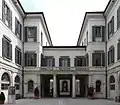 Palazzo Thun, seat of the mayor's office and the City Council
Palazzo Thun, seat of the mayor's office and the City Council Piazza Fiera, with part of the former city wall on the right-hand side
Piazza Fiera, with part of the former city wall on the right-hand side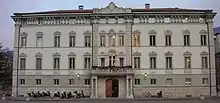 Palazzo Vescovile, seat of the local Catholic Diocese
Palazzo Vescovile, seat of the local Catholic Diocese Casa Cazuffi and casa Rella, in the central Piazza Duomo
Casa Cazuffi and casa Rella, in the central Piazza Duomo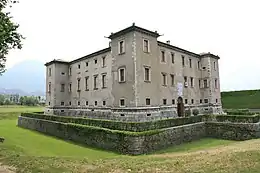 Palazzo delle Albere, formerly the Summer residence of the Prince-Bishop
Palazzo delle Albere, formerly the Summer residence of the Prince-Bishop Chiesa di San Francesco Saverio (St. Francis Xavier Church). The street is via Belenzani connecting the church façade with Piazza Duomo
Chiesa di San Francesco Saverio (St. Francis Xavier Church). The street is via Belenzani connecting the church façade with Piazza Duomo
Culture
Museums
- MUSE - Museo delle Scienze, museum of science and natural history. The museum was planned by Renzo Piano and opened in 2013.
- Municipal Gallery, part of the Museum of Modern and Contemporary Art of Trento and Rovereto (MART).
- Regional Museum of Art, in the Castello del Buonconsiglio, former seat of the Prince-Bishops of Trento.
- The Tridentine Diocesan Museum, located in the Palazzo Pretorio, next to the Cathedral Square of Trento, shows the artistic treasures of the diocese of Trento as well as the influence of the council on the city.
- Viote Alpine Botanical Garden, located on Monte Bondone in Le Viote, founded in 1938. Trento's surroundings are known for the mountain landscapes and are a destination of both summer and winter tourism.
- Museo dell'Aeronautica Gianni Caproni, an aeronautical museum located in Mattarello, near Trento's airport.
Theatre
- Teatro Sociale, realized in 1819
- Teatro Auditorium
- Teatro San Marco
- Teatro di Meano, located in the frazione of Meano
Events
- Economy Festival Trento
- Mountain Film Festival
- Christmas Market of Trento
- A Tutto Nosiola – Food and Wine Event
- Gemme di Gusto – Food and Wine Event
- DiVin Ottobre – Food and Wine Event
Education

The University of Trento was founded in 1962 and has its headquarters in the city of Trento. The other university location is in Rovereto. In total, over 16,000 students study in Trento. Through the Euroregion Tyrol-South Tyrol-Trentino, the university also works closely together with the universities of Innsbruck and Bolzano.
Transport
The Autostrada A22 (part of the European route E45) highway connects Trento to Verona and to Bolzano, Innsbruck and Munich.
Trento railway station, opened in 1859, forms part of the Brenner railway (Verona–Innsbruck), which is the main rail connection between Italy and Germany. The station is also a junction with the Valsugana railway, which connects Trento to Venice. Trento has several other railway stations, including Trento FTM railway station, terminus of the Trento-Malè-Marilleva railway (FTM).
Bus or train services operate to the main surrounding valleys: Fassa, Fiemme, Gudicarie, Non, Primiero, Rendena, Sole, Tesino, Valsugana.
The public transport network within the city consists of 20 bus lines operated by Trentino Trasporti and a funicular service to Sardagna. The various railway stations within Trento's city limits are integrated into the public transport network.

 Valsugana railway
Valsugana railway
Sport
Local teams
- Trentino Volley, one of the top teams in Italian volleyball, has won the Italian championship four times, three times the CEV Champions League title and five times the club world cup.
- Aquila Basket Trento has been playing regularly in the highest Italian basketball league for several years and reached the final of the play-offs in the 2016/17 season and 2017/18 season.
- A.C. Trento S.C.S.D. is one of the oldest football clubs in the region of Trentino Alto Adige since its foundation in 1921. Starting in 2021, the club is to play in the third highest Italian league, the Serie C.
Sports venues
PalaTrento, now known as BLM Group Arena, opened in 2000, is an indoor arena with a capacity of 4300 seats. Trentino Volley and Aquila Basket Trento play their respective games there.
- Stadio Briamasco is a football stadium with a capacity of 4277 seats and is currently the home stadium of AC Trento.
Notable people
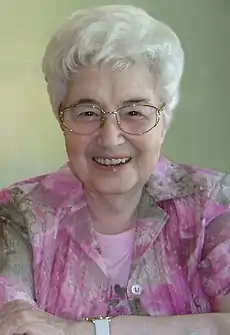
Notable people born in or associated with Trento include:
- Jacopo Aconcio (ca.1520–ca.1566), an Italian jurist, theologian, philosopher and engineer.[32]
- Beniamino Andreatta (1928–2007), an Italian economist and politician.
- Cesare Battisti (1875–1916), Italian patriot during the Italian irredentism
- Francesco Antonio Bonporti (1672–1749), an Italian priest and amateur composer.
- Aliprando Caprioli, engraver of the 16th-century
- Alcide De Gasperi (1881–1954), 30th Prime Minister of Italy and one of the founding fathers of the European Union
- Ernest von Koerber (1850–1919), an Austrian liberal statesman, prime minister of the Austrian portion of Austria-Hungary from 1900 to 1904
- Johann Baptist von Lampi the Younger (1775–1837) an Austrian portrait painter.
- Chiara Lubich (1920–2008), Italian teacher and author, founded the Focolare Movement
- Martino Martini (1614–1661), a Jesuit missionary, geographer, historian and missionary
- Paolo Oss Mazzurana (1833–1895), Trento's most notable mayor, with progressive economic policies that impacted Trento's commercial sector and its eventual independence
- Francesca Neri (born 1964), an Italian actress.
- Aldo Pancheri (born 1940), painter and printmaker[33]
- Antonio Pedrotti (1901–1975), an Italian conductor and composer
- Andrea Pozzo (1642–1709), Jesuit Brother, baroque painter and architect
- Galeas von Thun und Hohenstein (1850–1931), the Prince and Grand Master of the Sovereign Military Order of Malta from 1905 to 1931.
- Alessandro Vittoria (1525–1608), an Italian Mannerist sculptor of the Venetian school
- Hermann Zingerle (1870–1935), an Austrian neurologist, psychiatrist and neuropathologist
Sport

- Lorenzo Bernardi (born 1968), an Italian volleyball coach and former player, team silver medallist at the 1996 Summer Olympics
- Attilio Bettega (1953–1985), rally driver
- Alessandro Bonetti (born 1985), racing driver
- Mirko Bortolotti (born 1990), racing driver
- Thomas Degasperi (born 1981), water skier, two time World Champion
- Cesare Maestri (1929–2021), an Italian mountaineer and writer.
- Amos Mosaner (born 1995), an Italian curler, team gold medallist at the 2022 Winter Olympics
- Marvin Vettori (born 1993), an Italian professional mixed martial artist
- Renzo Videsott (1904–1974), an Italian alpinist and conservationist
International relations
Twin towns – sister cities
 Charlottenburg-Wilmersdorf (Berlin), Germany (1966)
Charlottenburg-Wilmersdorf (Berlin), Germany (1966) San Sebastián, Spain (1987)
San Sebastián, Spain (1987) Kempten, Germany (1987)
Kempten, Germany (1987) Prague 1, Czech Republic (2002)
Prague 1, Czech Republic (2002)
Districts of Trento are twinned with:[35]
 Schwaz, Austria
Schwaz, Austria Fließ, Austria
Fließ, Austria Ergolding, Germany
Ergolding, Germany Herrsching, Germany
Herrsching, Germany Neufahrn bei Freising, Germany
Neufahrn bei Freising, Germany Znojmo, Czech Republic
Znojmo, Czech Republic
Partner cities
See also
References
Notes
- "Superficie di Comuni Province e Regioni italiane al 9 ottobre 2011". Italian National Institute of Statistics. Retrieved 16 March 2019.
- "Popolazione Residente al 1° Gennaio 2018". Italian National Institute of Statistics. Retrieved 16 March 2019.
- Canepari, Luciano. "Trento". DiPI Online (in Italian). Retrieved 11 November 2018.
- Patuzzi, Umberto (2013). Unsarne Börtar [Our Words] (PDF) (in Italian, German, and Cimbrian). Lucerna, Italy: Comitato unitario delle linguistiche storiche germaniche in Italia / Einheitskomitee der historischen deutschen Sprachinseln in Italien. p. 9.
{{cite book}}: CS1 maint: unrecognized language (link) - "Trento | Italy | Encyclopædia Britannica". britannica.com. Retrieved 20 November 2016.
- "Population of Trento 2022 — Italy". www.aznations.com. Retrieved 18 August 2022.
- "Qualità della vita". Il Sole 24 ORE. Archived from the original on 28 November 2017. Retrieved 7 February 2018.
- "GDP per capita in the EU in 2011: seven capital regions among the ten most prosperous" (PDF).
- "Classifica Censis 2021/2022". CENSIS.
- "Le pagelle alle università". Il Sole 24 Ore. Archived from the original on 6 July 2017. Retrieved 7 July 2010.
- "La Scuola di Studi internazionali si laurea tra le migliori al mondo". UniTrento Press Room (in Italian). Retrieved 2 November 2021.
- Savio, Irene (30 May 2013). "» El 'Silicon Valley' italiano - Esglobal - Política, economía e ideas sobre el mundo en español" (in Spanish). Retrieved 2 November 2021.
- Griffith Taylor, "Trento to the Reschen Pass: A Cultural Traverse of the Adige Corridor", Geographical Review 30.2 (April 1940:215–237), "The site and evolution of the town of Trento", pp 220-.
- Cooley, Alison E. (5 January 2016). A Companion to Roman Italy. John Wiley & Sons. p. 285. ISBN 978-1-118-99311-8.
- Ando, Clifford; Richardson, Seth (26 May 2017). Ancient States and Infrastructural Power: Europe, Asia, and America. University of Pennsylvania Press. p. 127. ISBN 978-0-8122-9417-0.
- Taylor 1940:221.
- "Travel to TRENTO? Discover the Attractions of This Medieval Town". 29 November 2017. Retrieved 16 October 2023.
- "The New York Times – Breaking News, World News & Multimedia". iht.com. Retrieved 20 November 2016.
- The 16th-century original is Taylor 1940, fig. 6 p. 222.
- "Riva Di Trento". JewishEncyclopedia.com. Retrieved 22 April 2010.
- Majori, G (2012). "Short history of malaria and its eradication in Italy with short notes on the fight against the infection in the mediterranean basin". Mediterr J Hematol Infect Dis. 4 (1): e2012016. doi:10.4084/MJHID.2012.016. PMC 3340992. PMID 22550561.
- http://rockarch.org/publications/resrep/hall.pdf Archived 17 June 2013 at the Wayback Machine
- Vincenti, Piera (3 March 2020). "Smart City Index 2020, Trento is the most sustainable city in Italy | SmartGreen Post | news from the environment". Retrieved 30 March 2020.
- Taylor 1940:215, 224.
- "Tabelle degli indici climatici". www.climatrentino.it. APPA. Retrieved 15 January 2021.
- Trenti, Alberto (7 June 2017). "Nevicate a Trento dal 1920-2017" (PDF). www.meteotrentino.it. Meteotrentino. Retrieved 27 September 2021.
- "Statistiche demografiche ISTAT". Demo.istat.it. Archived from the original on 26 April 2009. Retrieved 22 April 2010.
- Taylor 40:224.
- Un balzo nel passato Archived 22 July 2011 at the Wayback Machine (in Italian). Giro al Sas. Retrieved 2010-11-03.
- Albo d’oro dal 1962 al 2009 Archived 7 December 2010 at the Wayback Machine. Giro al Trentino. Retrieved 2010-11-03.
- "Economy Festival Trento". trentino.com. Retrieved 2 December 2017.
- Pollard, Albert Frederick (1911). . Encyclopædia Britannica. Vol. 1 (11th ed.). p. 151.
- III [i.e. Terza] Rassegna internazionale d'arte Acireale ... Matteo Donato, Antonino Rizzo - 1969 "La barriera » - frottage a colori 50 x 60 « Fondale incandescente » - frottage a colori 50 x 60 ALDO PANCHERI è nato a Trento nel 1940 Personali a Trento e Brescia. Ha partecipato a vane esposizioni collettive ed in particolare: 1963."
- "Gemellaggi col Comune". comune.trento.it (in Italian). Trento. Retrieved 18 December 2019.
- "Gemellaggi con le Circoscrizioni". comune.trento.it (in Italian). Trento. Retrieved 18 December 2019.
Further reading
- Kay, David (1880), "Principal Towns: Trent", Austria-Hungary, Foreign Countries and British Colonies, London: Sampson Low, Marston, Searle, & Rivington, hdl:2027/mdp.39015030647005
- T. Francis Bumpus (1900), "Trent", The Cathedrals and Churches of Northern Italy, London: Laurie
- Coolidge, William Augustus Brevoort (1911). . Encyclopædia Britannica. Vol. 27 (11th ed.). p. 247.


